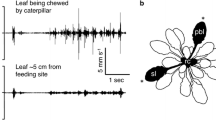Summary
-
1.
The mechanoreceptive campaniform sensilla, which are arranged in groups on insect legs, were studied in the stick insect Cuniculina impigra. In middle and rear legs, the most posterior trochanteral campaniform group (group 1) is oriented so as to be stimulated by compressional cuticular forces acting on the posterior articulation of the trochanter with the coxa.
-
2.
Recordings from nerve Tr2, which innervates this campaniform group, confirmed that the sensilla were directionally sensitive to cuticular stress generated by imposed or active movements of the femur. Different individual sensilla had different thresholds of response, but all responded qualitatively in the same way to a given stimulus.
-
3.
Posteriorward horizontal deflection of the femurtrochanter relative to the coxa (at right angles to the normal plane of movement) produced a strong excitation of the group 1 sensilla. Anteriorward horizontal deflection caused a sharp reduction of on-going background activity in the group. Imposed vertical movements of the femur usually had little effect on the activity of the campaniform sensilla.
-
4.
Active depression of the femur-trochanter by the animal reduced on-going background activity in proportion to the strength of the depression movement. Elevation that simulated muscle-generated lifting of the leg strongly increased activity.
-
5.
It is concluded that campaniform group 1 functions to signal passive horizontal and active vertical movements around the trochantero-coxal joint of the leg. This dual pattern of response means that the animal cannot interpret signals from this campaniform group without also having information about muscle activity.
Similar content being viewed by others
References
Bässler U (1977) Sensory control of leg movement in the stick insect Carausius morosus. Biol Cybern 25:61–72
Delcomyn F (1971) The effect of limb amputation on locomotion in the cockroach Periplaneta americana. J Exp Biol 54:453–469
Delcomyn F (1985a) Factors regulating insect walking. Annu Rev Entomol 30:239–256
Delcomyn F (1985b) Walking and running. In: Kerkut GA, Gilbert LI (eds) Comprehensive insect physiology, biochemistry and pharmacology, vol. 5. Nervous system: structure and motor function. Pergamon Press, Oxford, pp 439–466
Hofmann T, Bässler U (1982) Anatomy and physiology of trochanteral campaniform sensilla in the stick insect, Cuniculina impigra. Physiol Entomol 7:413–426
Hofmann T, Bässler U (1986) Response characteristics of single trochanteral campaniform sensilla in the stick insect, Cuniculina impigra. Physiol Entomol 11:17–21
Hoyle G (1978) Intrinsic rhythm and basic tonus in insect skeletal muscle. J Exp Biol 73:173–203
Krämer K, Markl H (1978) Flight-inhibition on ground contact in the American cockroach, Periplaneta americana. I. Contact receptors and a model for their central connections. J Insect Physiol 24:577–586
McIver SB (1985) Mechanoreception. In: Kerkut GA, Gilbert LI (eds) Comprehensive insect physiology biochemistry and pharmacology, vol. 6. Nervous system: Sensory. Pergamon Press, Oxford, pp 71–132
Pearson KG (1972) Central programming and reflex control of walking in the cockroach. J Exp Biol 56:173–193
Pringle JWS (1938) Proprioception in insects. II. The action of the campaniform sensilla on the legs. J Exp Biol 15:114–131
Schmitz J, Büschges A, Delcomyn F (1988) An improved electrode design for en passant recording from small nerves. Comp Biochem Physiol 91A:769–772
Spinola SM, Chapman KM (1975) Proprioceptive indentation of the campaniform sensilla of cockroach legs. J Comp Physiol 96:257–272
Zill SN (1990) Mechanoreceptors: exteroceptors and proprioceptors. In: Huber I, Masler EP, Rao BR (eds) Cockroaches as models for neurobiology: Applications in biomedical research, vol. II. CRC Press, Boca Raton, pp 247–267
Zill SN, Moran DT (1981a) The exoskeleton and insect proprioception. I. Responses of tibial campaniform sensilla to external and muscle-generated forces in the American cockroach, Periplaneta americana. J Exp Biol 91:1–24
Zill SN, Moran DT (1981b) The exoskeleton and insect proprioception. III. Activity of tibial campaniform sensilla during walking in the American cockroach, Periplaneta americana. J Exp Biol 94:57–75
Zill SN, Moran DT, Varela FG (1981) The exoskeleton and insect proprioception. II. Reflex effects of tibial campaniform sensilla in the American cockroach, Periplaneta americana. J Exp Biol 94:43–55
Author information
Authors and Affiliations
Rights and permissions
About this article
Cite this article
Delcomyn, F. Activity and directional sensitivity of leg campaniform sensilla in a stick insect. J Comp Physiol A 168, 113–119 (1991). https://doi.org/10.1007/BF00217109
Accepted:
Issue Date:
DOI: https://doi.org/10.1007/BF00217109




